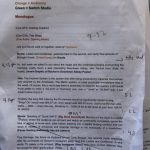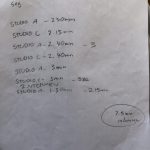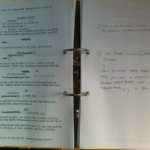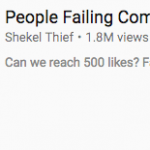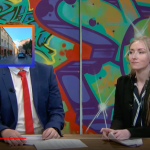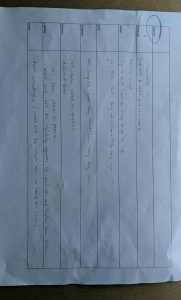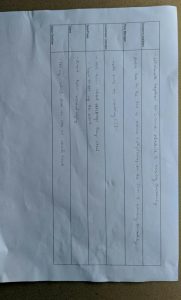The conclusion of Ready Camera One has brought to light several old existing ideas/concepts and also opened my eyes to several more. As a finale project, we embarked on a 2-3 week long journey of creating and producing our very own live show with ( very real ) live audience members. Our concept revolved around a breakfast talk show at midnight. The structure of the show followed very closely other shows like Saturday Night Live and even The Late Show with Stephen Colbert. We had elements of humour injected with mainstream news, just an average student production.
Following the pre-production planning, we knew our show had to go with a specific flow. This translated to having,
- introduction –
- monologue –
- news segment –
- skit –
- short news stories –
- skit –
- main news story –
- skit –
- interview –
- conclusion.
It can be said that this standard of having news stories broken up by skits and mini segments is a form os stylistic exhibitionism that several television genres are favourable off. ( Caldwell J T, 1995 pg 18 ) Caldwell explains in his book on Televisuality: Style, Crisis and Authority in American Television ( 1995 ) that television genres like daytime talk shows, nonprimetime public affairs shows etc all have a specific pattern or flow that the follow. Thus, we fed off that information and used it as a guide when creating our live production.
Touching again on the idea that our show had aspects of stylistic exhibitionism was the fact that the genre that Midnight Snack fell into had the tendency to call out on it’s own ‘liveness’. Caldwell (1995 ) explains that ‘ These genres stress liveness through quite traditional series of indices, such as the direct address to the viewer…..”. This, in which, we clearly display by addressing our live studio audience during the start of the show and sometimes even with the hosts encouraging audience interactions through laughing. Marriot ( 2007 ) also touches on this aspect of live, calling it the ‘discourse of immediacy’ which is the act of constantly going out of the way to emphasize the liveness of the broadcast. Which the Nicole and Jaie constantly bring up by saying ‘… take your time we’re only live’ and also during the interview when Pat asks if laugh tracks can be added in post and Jaie said ‘ yeah.. but we’re live so, no’. ( episode 2 )
Both episodes followed this specific genre flow, with stories and segments changing depending on the relevancy of each topic. For instance our first episode’s news segment was centralised heavily on the Royal Wedding as it was a few days before the special occasion while our second episode centralised on the Facebook data scandal which was the talk of the town a few days before we went live.
Of course, as amateur media professionals, we didn’t know what we were doing half the time and it was very apparent for me, especially, when I stood in for the role of the DA in the second episode. While I generally knew what was expected of me through having prior experience of being a DA in the last assignment, I could safely say that the weight and size ( not literally ) of A3 was minor in comparison to Midnight Snack. Orchestrating a 25-30 minute live show was significantly much more challenging than a mere 5 minute one. In the week 7 reading, Doing It Live (MacDonnell J,2005 ), we follow the planning an executing of a live drama show, The Bill. I felt like it was a good precursor for us students as it shaped what we should be expecting for the two live episodes. I also would like to think that my script/runsheet acted similarly to the ‘production bible’ that MacDonnell described hers. Below, I have added pictures of my script and hers for comparison
- Page 1 of script/runsheet
- Taking notes of each segment duration
- Joanna MacDonnell’s ‘Production Bible’
Tasked with the role of the DA for episode 2, I knew that if I didn’t know what was to happen when and for how long, then the show wouldn’t be cohesive. I struggled a bit during the rehearsal times for episode 2 as I felt we gave much more attention to episode 1, neglecting the latter. Scripts were not finalised until the morning of the show and even on our last rehearsal round, we were still adding EVS items into the show. As we’ve discussed in earlier weeks of the studio, it was most definitely scheduled chaos..
While I felt relatively prepared going into the last live show, it still was a little unnerving knowing that not everything might go as according to planned ( as it most usually does not ). However, no amount of rehearsal time or preparation could prepare us for liveness, because as many of our scholars have mentioned before- anything can happen live, which brings me to my next point.
Part of the appeal we have for live television is the idea that anything could happen and we would be witnesses to it as it is happening. As much as I would love to hedge all humans as being a decent and optimistic bunch, we just aren’t. We like to laugh at people’s demise, errors and mishaps. That’s why video compilations of people falling down can reach up to 1.8 Mil views ( see image below ). Similarly, Gadassik (2010) stresses on the fact that when New York Times release ‘ TV’s Best Live Moments ‘, none of the events included significant political or national occurances but rather moments of Janet Jackson’s bare breasts etc. When I asked some of my friends why they watched the livestream of our first episode, they said they wanted to witness my less-than-perfect performance on-screen. Just like when Jaie’s friends screen-grabbed the exact moment when graphics was covering his entire face in Episode 1. ( as I also have, so generously, included as well down below ) To summarise, ‘ the attraction of television liveness, as an idealogical ( or stimulated? ) media construction, depends precisely on such brief, unexpected ruptures in television’s controlled daily flow.’ ( Gadassik, 2010 pg 117-118 )
- Video Compilation of people falling on Youtube
- Graphic covering Jaie’s face
While nothing significantly jarring happened and both shows went by fairly on-time and smoothly. These little instances of mishaps are what makes up the liveness of our production. Even times of delay when cutting to different studios or even when we can still hear floor managers counting down in the background ( episode 1, 22:00-22:05 ).
Touching very briefly on my role as sets/props for episode 1, I knew it would be a much easier feat than my DA role as long as I stayed well informed of what was needed on sets. There wasn’t much for me to bring in terms of props because we kept the scripts fairly simple and manageable- my main worry for episode 1 was my on-screen performance as Miss Meghan Markle ( now Duchess of Sussex ).
I think our production was authentic in creating television liveness in a sense that it had aspects of intimacy when addressing the audiences directly – so that they felt they were connecting to something ‘real’. It also had aspects of immediacy in a sense that they audience knew they were witnessing something as it was happening, be it through the hosts explicitly mentioning it or even during our instances of mishap and delays. These aspects brought up the liveness of our production and it was what separated us from post-production work.
Personally, I appreciate live television productions because of it’s very rawness and authenticity. While all media texts are controlled and manipulated to show you only what they want to show you – live tv production included, I feel that there is a sense of an anticipation almost, a rawness to live tv. Being behind the scenes, live tv gives that kind of rush that I haven’t encountered in other forms of media productions during my course in RMIT. Ready Camera One felt like a haunted house, always keeping me on my toes- I’m always expecting something terrible at every corner and ready to face it. While other media productions feel like a slow canoe ride through the Yarra River almost, slow and predictable with some obstacles in the middle but nothing that gives you the same rush from live tv production.
All things considered, I think we did an amazing job with our two episodes and definitely gave it our best shot. Although I wasn’t able to touch on and analyse most other aspects of the production planning such as social media and writing ( mainly because I wasn’t tasked with the job ), with the roles and experiences that I’ve had during the two shows, it was enough for me to fully understand the idea of liveness- from talking about it in class to actually living in out in our last two weeks. I can safely say I have learnt a great deal about what it means to produce a live television programme as well as to be more aware of how I consume my live television programmes.
References:
Bourdon J, 2000, Live Television is still alive: on television as an unfulfilled promise, Media and Culture Society 22(5), Sage Publications, London, pg 531-556.
Marriott S, 2007, Live Television: Time, Space and the Broadcast Event, Sage Publications London, pg 59-72
Caldwell J T, 1995, Televisuality: Style, Crisis and Authority in American Television, Rutgers University Press, pg 18.
Gadassik A, 2010, At a Loss for Words: Televisual Liveness and Corporeal Interruption, Journal of Dramatic Theory and Critisism, pg 117-133.
MacDonnell J, 2005, Doing It Live! Planning and Preparing for a Live Drama Episode: a case study of The Bill, Journal of European Television History & Culture, vol 2 issue 4, pg 27-44
